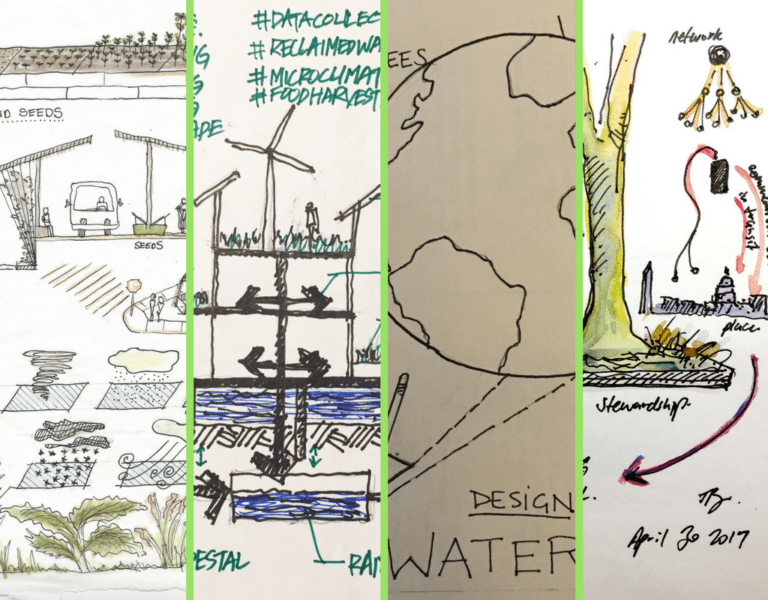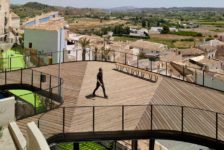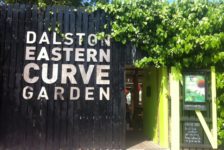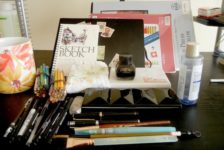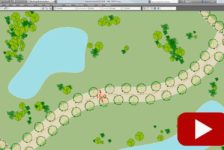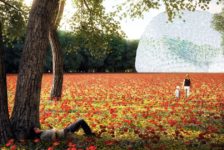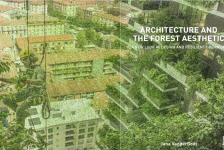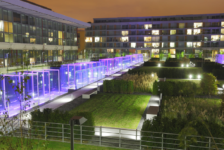Anova Furnishings’ Grant Competition is back again this year, offering emerging professionals the opportunity to attend the 2018 ASLA Annual Meeting and EXPO in Philadelphia. Centered around a different topic each year, the competition invites participants to submit a short essay and a quick napkin sketch between April 13 to May 14, 2018 for the chance to win a $2,000 grant toward conference expenses. A panel of three practicing Landscape Architects will select the 21 best responses to be awarded the grant.
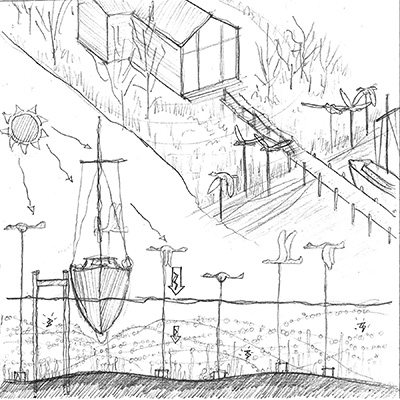
Participants of the 2017 Anova Grant were asked to address the issues of climate change within their region. 1st place winner, Steve Makrinos of Annapolis, MD, sketched Electric Reefs on Chesapeake Bay waterfronts, which would act as resilient buffers–rapidly reestablishing oyster reefs and subaquatic vegetation.
To get the inside-scoop on what the jurors are looking for, I interviewed two of this year’s jurors, Stephanie Rolley, Professor and Department Head of LARCP at Kansas State University, and Annette Wilkus, Partner at SiteWorks. Here’s what they had to say. Interviews have been edited and condensed.
First, tell me a bit about the competition, and why you wanted to be a part of it.
SR: I was very excited when Eric Gilbert, the CEO of Anova, called and asked if I would be interested in participating as a juror because I have been so impressed by Anova’s support of emerging professionals. I have been involved with ASLA for many decades with a focus on students and young professionals, and it’s so hard to get students to attend the ASLA Annual Meeting because of the cost to attend. We need to have them there for us to be able to benefit from their shared knowledge.
AW: I thought it was really amazing that a furniture company wanted to promote education for young professionals and make sure that they can get to the ASLA Annual Meeting. I thought it was a very interesting idea that Eric had and I’ve never seen any other similar company do something like this. I think it’s really important to try to encourage young professionals to be involved in the profession and our national organization, and this competition really encourages that.
What will the jury be looking for in a winning submission?
SR: One of the themes of this competition that stays true over the years is that the primary focus is on ideas and people expressing those ideas through drawing – focusing more on conveying the concept and worrying less about the presentation. It’s a unique aspect of what we do for this competition because so much of what we do in design is focused on very final highly developed graphics. This competition is focused on having people present their ideas and do it in a way that is uniquely personal to them and maybe not professionally typical.
AW: To me, it’s seeing how thoughtful the submitter is – and if they can write complete sentences is always a good thing. I was one of the first jurors and I’ve always pushed that the napkin sketch isn’t about making something pretty. It’s about being in a meeting and being able to communicate something quickly. This is a great way to practice quickly getting your thoughts across – drawing can help you explain something that will click into the audience’s mind quicker than just talking would. That’s why the sketch is really important, but it does not have to be perfect. It just needs to match what you’re talking about.
What about those of us who are still working on our drawing abilities? Are we still encouraged to apply?
SR: Definitely. And, when you look at the gallery of previous winners, you can see that. You can see that some people have a very refined hand and can probably make anything look like a work of art and there are others who are less refined and equality enthusiastic about their ideas.
AW: Oh yeah. Absolutely!
Can you describe examples of past winning submissions and what makes a strong submission?
SR: The strong submissions have a very strong imagination and focus on innovation and thinking about the future – moving beyond current conversations and ideas about landscape architecture to envision what will be important for the future. And the other trend is an enthusiastic drawing – not highly refined, just very enthusiastic that shows someone’s passion for their idea.
AW: There’s one I can remember that was probably a more refined sketch than I would have expected, but it was talking about a really innovative way to help suggest a solution for some of the environmental things that were happening in their community. It was a really innovative way of taking a boat and adding sun panels. It had a short written part that matched the sketch perfectly.
This competition is exclusively for up-and-coming landscape architects, and the winners are awarded $2,000 to attend the 2018 ASLA Annual Meeting in Philadelphia. Why do you think it’s important that young professionals attend the Annual Meeting?
SR: I think it’s essential because young professionals are the future of our profession. They need to be leading our profession, and one of the best ways to do that is to come to the biggest collection of landscape architecture professionals in the U.S. and participate in the conversation. I think for years the meetings have been accessible largely to people who are pretty far along in their careers because it is an expensive venture to travel to the host city and attend the Meeting, so it makes a big difference that Anova is making this accessible to younger people. When you look at the number of awards given, that’s critical because it’s not just one or two special people being invited to attend the Meeting. Through this competition, Anova is helping to change the demographic of ASLA.
AW: Because you can learn so much. It gives you exposure beyond what office you’re working in. You can see what other practitioners are doing. Sitting in the lectures you can learn quite a bit ranging from super innovative to going back to the basics of communicating better, or providing better construction drawings. There are some really technical presentations at the Annual Meeting and then there are some really innovative things happening. You get to see the big names in landscape architecture and hear them speak. It gets you involved in the profession. We have a hard enough time explaining what landscape architects do, so it’s great to be in such a motivational space with others in your profession.
This year’s competition asks participates to describe a space that influenced their career in landscape architecture, which can help others relate to the profession. If you could enter the competition, how would you respond?
SR: Upper Bear Creek in Colorado was an important part of my childhood. Playing in the water, sliding down rock chutes, trying to catch fish, weaving necklaces of flowers from the bank, and falling asleep to the sound of the rapids were experiences that shaped my appreciation for nature. When I realized that landscape architects design places that immerse others in those experiences and many more, I knew I’d found my future.
AW: That’s a tough one for me because it wasn’t really a place or space that influenced me. I was working at a greenhouse and the landscape architect there introduced me to landscape architecture. The profession wasn’t really acknowledged in the 70’s, so I wouldn’t have heard of it if not for him.
—
Through this grant, Anova is not only increasing the diversity of voices at the Annual Meeting, but also providing an opportunity to showcase the profession and its ability to help solve today’s challenges. To learn more about the competition and submit your entry, visit the competition website. Submissions will be accepted from April 13 to May 14, 2018.
Published in Blog, Cover Story, Featured


